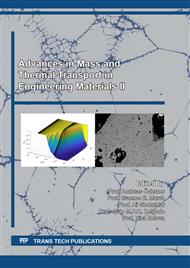[1]
M.S. Nascimento, C. Frajuca, F.Y. Nakamoto, G.A. Santos, A.A. Couto: Matéria Vol. 22 (1) (2017). ISSN 1517-7076 artigo e11774. https://doi.org/10.1590/S1517-707620170001.0106.
DOI: 10.1590/s1517-707620170001.0106
Google Scholar
[2]
M.S. Nascimento, A.T.R. Franco, C. Frajuca, F.Y. Nakamoto, G.A. Santos, A.A Couto: Materials Research Vol. 21 (5) (2018). https://doi.org/10.1590/1980-5373-MR-2017-0864.
Google Scholar
[3]
Nascimento MS, Santos GAd, Teram R, Santos VTd, Silva MRd, Couto AA. Effects of Thermal Variables of Solidification on the Microstructure, Hardness, and Microhardness of Cu-Al-Ni-Fe Alloys. Materials. (2019); 12(8):1267. https://doi.org/10.3390/ma12081267.
DOI: 10.3390/ma12081267
Google Scholar
[4]
Santos GA, Ribeiro AN, Nascimento MS, Frajuca C, Nakamoto FY, Silva MR, et al. Influence of the thermal parameters on the microstructure, corrosion resistance and hardness on the unidirectional solidification of al-10wt% si-5wt% cu alloy. Mater Sci Forum 2020;1012 MSF:308-313.
DOI: 10.4028/www.scientific.net/msf.1012.308
Google Scholar
[5]
Cruz RA, Santos GA, Nascimento MS, Frajuca C, Nakamoto FY, da Silva MR, et al. Microstructural characterization and mathematical modeling for determination of volume fraction of eutectoid mixture of the cu-8.5wt% sn alloy obtained by unidirectional upward solidification. Mater Sci Forum 2020;1012 MSF:302-307.
DOI: 10.4028/www.scientific.net/msf.1012.302
Google Scholar
[6]
I. Richardson, Guide to Nickel Aluminium Bronze for Engineers. Copper Development Association publication Nº222, (2016).
Google Scholar
[7]
F. Hasan, A. Jahanafrooz, G.W. Lorimer, N. Ridley, The Morphology, Crystallography, and Chemistry of Phases in As-Cast Nickel-Aluminium Bronze, Met.Trans. A, v. 13a, pp.1337-1345, (1982).
DOI: 10.1007/bf02642870
Google Scholar
[8]
Y. Li, T. L. NGAI, W. Xia, Y. Long, D. Zhang, A study of aluminum bronze adhesion on tools during turning. Journal of materials processing technology, v. 138, n. 1-3, pp.479-483, (2003).
DOI: 10.1016/s0924-0136(03)00123-7
Google Scholar
[9]
A. E. Diniz, A rugosidade superficial da peça em processos de torneamento: critérios de fim de vida da ferramenta e fatores de influência, (1989).
DOI: 10.47749/t/unicamp.1989.47604
Google Scholar
[10]
K. G. Shashi, N. D. Prasanna, machinability studies on copper based alloy-optimization of control parameters in turning operation using Taguchi method. International journal of engineering research & technology (IJERT), ISSN: 2278-0181, Vol. 2 Issue 7, (2013).
Google Scholar
[11]
J. Paulo Davim, V.N. Gaitonde, S.R. Karnik, Investigations into the effect of cutting conditions on surface roughness in turning of free machining steel by ANN models, Journal of Materials Processing Technology, Volume 205, Issues 1–3, 2008, Pages 16-23.
DOI: 10.1016/j.jmatprotec.2007.11.082
Google Scholar
[12]
Vikram, K. A., Ratnam, C., Narayana, K. S., & Ben, B. S. (2015). Assessment of surface roughness and MRR while machining brass with HSS tool and carbide inserts, Indian Journal of Engineering and Materials Sciences, 1 June 2015, Vol.22(3), pp.321-330.
Google Scholar
[13]
Fu, X., Zou, B., Liu, Y., Huang, C., & Yao, P. (2019). Edge micro-creation of Ti (C, N) cermet inserts by micro-abrasive blasting process and its tool performance. Machining Science and Technology, 23(6), 951-970.
DOI: 10.1080/10910344.2019.1636275
Google Scholar
[14]
Zhao, T., Zhou, J. M., Bushlya, V., & Ståhl, J. E. (2017). Effect of cutting-edge radius on surface roughness and tool wear in hard turning of AISI 52100 steel. The International Journal of Advanced Manufacturing Technology, 91(9), 3611-3618.
DOI: 10.1007/s00170-017-0065-z
Google Scholar
[15]
Wang, W., Saifullah, M. K., Aßmuth, R., Biermann, D., Arif, A. F. M., & Veldhuis, S. C. (2020). Effect of edge preparation technologies on cutting edge properties and tool performance. The International Journal of Advanced Manufacturing Technology, 106(5), 1823-1838.
DOI: 10.1007/s00170-019-04702-1
Google Scholar
[16]
Denkena, B., and D. Biermann. Cutting edge geometries." CIRP annals 63.2 (2014): 631-653. [17] Wyen, C-F., and Konrad Wegener. "Influence of cutting edge radius on cutting forces in machining titanium., CIRP annals 59.1 (2010): 93-96.
DOI: 10.1016/j.cirp.2010.03.056
Google Scholar
[18]
Konopka, John. Options for quantitative analysis of light elements by SEM/EDS., Technical Note 52523 (2013).
Google Scholar


